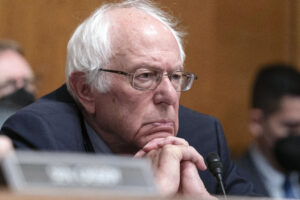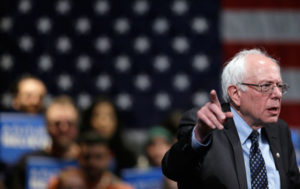Fair and Prosperous Socialism in America May Be Closer Than You Think
Historian and activist Gar Alperovitz argues that many socialist institutions exist in the U.S. with the support of both liberal and conservative citizens and politicians—and many more are in the making. Desiree Williams / CC BY-ND 2.0
Desiree Williams / CC BY-ND 2.0
Historian and activist Gar Alperovitz argues in a long, detailed article published in The Nation that many socialist institutions exist in the United States with the support of both liberal and conservative citizens and politicians—and many more are in the making.
“[N]ew resources have become available to support the construction of a serious alternative system, one that is ‘socialist’ in content and vision, but also highly democratic and accountable in structure,” Alperovitz writes.
Correctly presented to Americans of differing backgrounds and political inclinations, the changes Alperovitz proposes could appeal to both liberals and conservatives because they could both improve the benefits Americans enjoy and significantly reduce taxes.
“In recent years,” he offers, “there has been a steady buildup of interest in new forms of democratized ownership.”
Worker-owned cooperatives, neighborhood land trusts, and municipal corporations all democratize ownership in one way or another, but they do so in decentralized rather than statist fashion. The trajectory of change is impressive. Examples of successful worker ownership range from Cooperative Home Care Associates in New York City to the Evergreen complex of solar, greenhouse, and laundry cooperatives in Cleveland. Mayors and city councils in places like Austin, Texas; Madison, Wisconsin; Richmond, California; and New York City have started to provide direct financial or technical support for these developments, suggesting a new nexus of political power. …
Cities have also begun to support other forms of public ownership. Communities as diverse as Philadelphia, Pittsburgh, and Santa Fe, New Mexico, are working to establish municipally owned banks. In Boulder, Colorado, climate-change activists have triumphed over intense corporate opposition in two major referendum battles to municipalize the local utility. More than 250 community land trusts—a model of city and neighborhood development in which land is socialized to prevent gentrification—have been set up across the country, building on the foundational work done by the Champlain Housing Trust in Burlington, Vermont.
Some 450 communities have also established municipally owned Internet systems, commonly against powerful corporate opposition. In recent years, legislators in 17 states have introduced bills to create state-owned public banks like the nearly century-old Bank of North Dakota. Roughly the same number of states have considered legislation to establish single-payer healthcare programs. In 2016, voters in Colorado will decide via referendum on the single-payer ColoradoCare initiative.
The potential for significantly reducing taxes is real, he says:
… [A] number of states have gained a great deal of experience owning and managing land, real estate, and mineral rights—and many use the proceeds to fund social services and reduce taxes, although this fact hasn’t received much attention.
Almost 150 years ago, for instance, Texas’s Permanent School Fund took control of about half the land and associated mineral rights in the public domain. In 1953, the state added coastal “submerged lands” to the portfolio after the federal government relinquished them. Each year, distributions from the earnings support education in every county of Texas ($838.7 million in fiscal year 2015 alone). Another fund, the Permanent University Fund, owns more than 2 million acres of land and helps underwrite the state’s public-university system. In these and other cases, social ownership supports public education in ways that also significantly reduce the tax burden.
Similar sovereign-wealth funds exist in Louisiana, New Mexico, Wyoming, and North Dakota. Alaska, of course, famously collects and invests revenue from extraction of the state’s oil and minerals. Dividends are paid out annually to state residents as a matter of legal “right”—the only practical model in the United States of publicly supported income with no additional work requirement. In 2008, under the governorship of Tea Party favorite Sarah Palin, each resident received $2,069—over $10,000 for a family of five—from these “socialized” funds. That year, Palin also signed into law a bill that gave every resident an extra $1,200 from the state’s natural-resource revenues.
He also writes that the management of large-scale industry can be broken down and consolidated regionally:
An obvious question is what to do about large-scale industry—a subject that many have simply avoided, preferring instead to focus on local strategies. Yet even the economist and self-proclaimed socialist E.F. Schumacher, author of the classic Small Is Beautiful, judged that “the idea of private ownership becomes an absurdity” on a larger scale. Americans witnessed this during the most recent financial crisis, when the federal government de facto nationalized several banks, two auto companies, and the insurance giant AIG. The government gave them back once the crisis was over, but when the next crisis hits, a future progressive government might well turn them into publicly owned features of a new system. (Breaking up the banks, as some have proposed, would likely produce a subsequent reconsolidation of power—as AT&T and Standard Oil showed after they were broken up.)
A major problem involves the inevitable institutional power that comes with such large scale. During the 1960s and ’70s, the pathbreaking radical historian William Appleman Williams suggested that one way for socialists to deal with this challenge was to focus on regions rather than the national system as a whole—especially in a country the size of the United States.
Modern innovators are bringing a similar idea to life as they experiment with regional models. “Bio-regional” efforts that anchor economic, social, and environmental development in natural regions can be found in places as diverse as the Connecticut Valley and the Ozark Mountains. The Kansas Area Watershed Council, for example, supports sustainable development in the prairie region through a range of projects and community-building events, and the Salmon Nation project is bringing a similar perspective to the Pacific Northwest. Nine states, mainly in New England, have formed the Regional Greenhouse Gas Initiative to reduce emissions. Another effort, Food Solutions New England, has put forward a comprehensive plan to develop a robust, collaborative, sustainable, and equitable regional food system by 2060.
“None of this is to suggest that large-scale political change is imminent or inevitable,” Alperovitz writes.
Social, economic, and environmental conditions—to say nothing of assaults on traditional liberties—are likely to get worse before they get better. For precisely this reason, the systematic development of a practical alternative to the status quo is critically important.
The change we need will not come from the top. As we’ve seen in countless ways, our current political system limits the potential for traditional progressive strategies. A new vision—one that encompasses fresh political strategies as well as new political-economic content—must be built from the bottom up. The overarching goal must be to develop a set of ideas that challenge the dominant ideologies and move the country in a fundamentally new direction.
The Sanders insurgency, the polling data, and the growing experimentation with a range of alternatives all suggest that we may be on the brink of a new era—an extended and difficult period in which a new economy is slowly forged. Such a system might perhaps be called a “pluralist commonwealth” to reflect its diverse forms of common ownership. But whatever we call it, it is time to start discussing this system more openly and to refine its practical elements. As ever-greater numbers of Americans are forced to ask fundamental questions about where their nation is going, we must start offering the answers.
—Posted by Alexander Reed Kelly.
Your support matters…Independent journalism is under threat and overshadowed by heavily funded mainstream media.
You can help level the playing field. Become a member.
Your tax-deductible contribution keeps us digging beneath the headlines to give you thought-provoking, investigative reporting and analysis that unearths what's really happening- without compromise.
Give today to support our courageous, independent journalists.






You need to be a supporter to comment.
There are currently no responses to this article.
Be the first to respond.